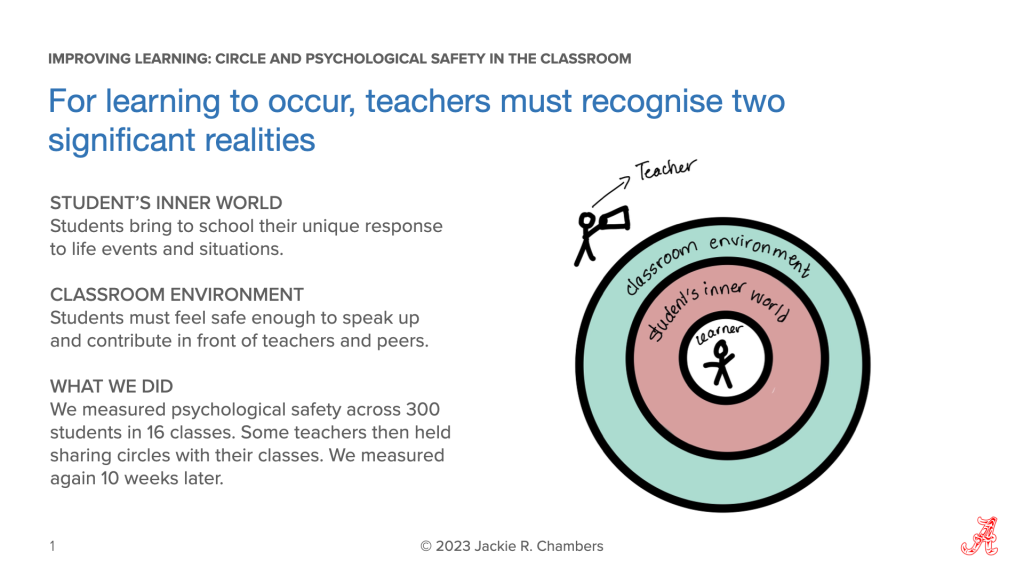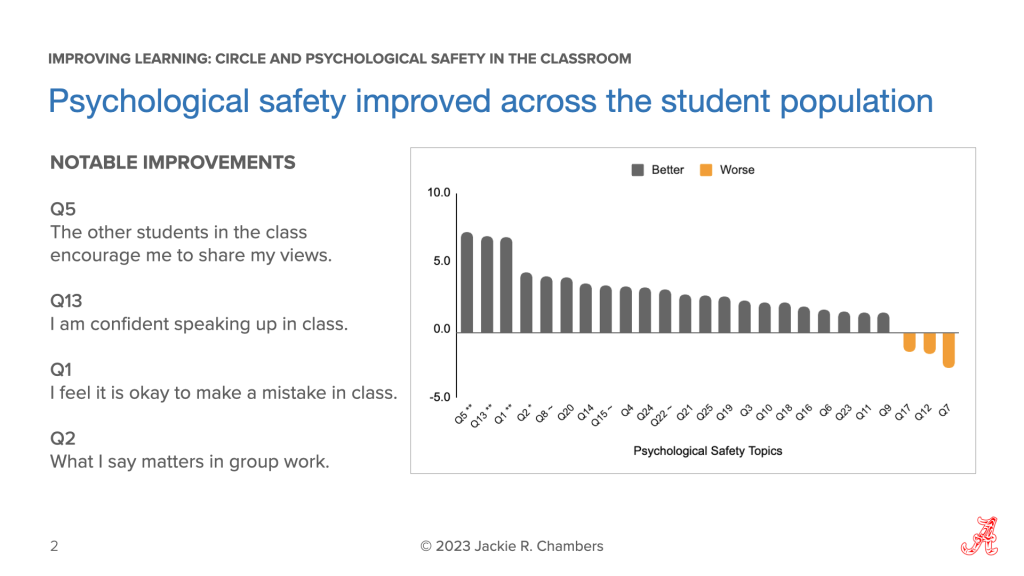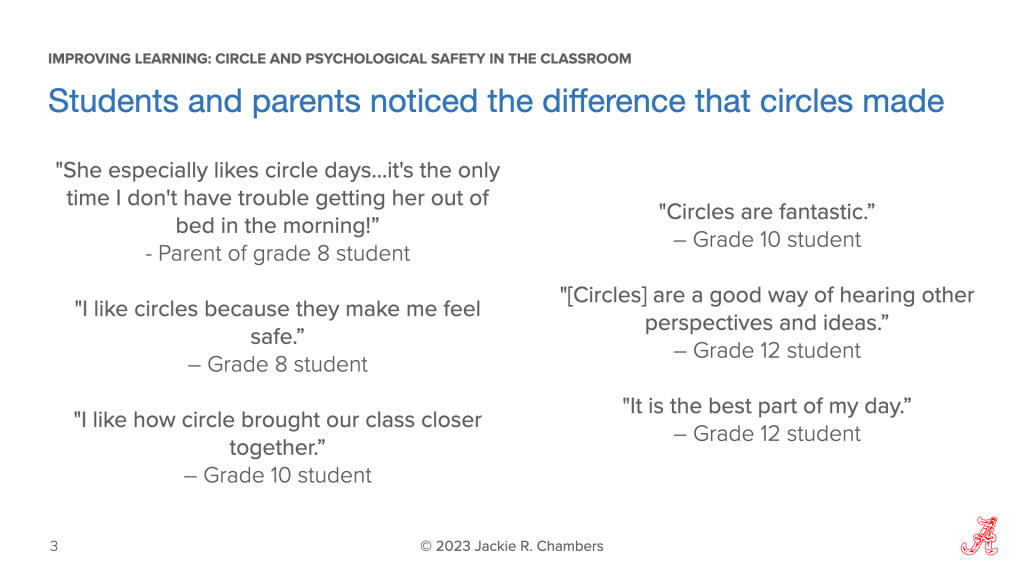I. General Information
School Name: Alberni District Secondary School
School District: SD#70 Pacific Rim
Inquiry Team Members: Jennifer Anderson: janderson@sd70.bc.ca, Jeannette Badovinac: jbadovinac@sd70.bc.ca, Jackie Chambers: jchambers@sd70.bc.ca, Shelley Frank: sfrank@sd70.bc.ca, Tasha Gallagher: tgallagher@sd70.bc.ca, Erika Ingram: eingram@sd70.bc.ca, Maryann Gillis: mgillis@sd70.bc.ca, Rachel Reynolds: rreynolds@sd70.bc.ca, Jen Rogers: jrogers@sd70.bc.ca
Inquiry Team Contact Email: jchambers@sd70.bc.ca
II. Inquiry Project Information
Type of Inquiry: NOIIE Case Study
Grade Levels Addressed Through Inquiry: Secondary (8-12)
Curricular Areas Addressed: Language Arts – Oral Language
Focus Addressed: Core competencies (for example, critical thinking, communication, problem solving), Self-regulation, Social and emotional learning, Other: Connection/ psychological safety
In one sentence, what was your focus for the year? We wanted to see if talking circle was an effective strategy to increase psychological safety in the classroom, so that students could more easily engage in learning.
III. Spirals of Inquiry Details
Scanning: According to the OECD (2012), “emotions are the gatekeepers of learning…, whether negative emotional states are the result of classroom experiences or of experiences outside that are carried into the learning environment by the student.” How can teachers be sure that their classroom environment doesn’t negatively impact their students?
We notice that some students attend classes regularly and engage in learning activities, but some do not. Some go to class but do not engage, whereas others come to school but have a difficult time staying in class. Yet still others don’t come to school at all. We wanted to know why. More specifically, we wanted to know if the teacher can directly influence the classroom environment to create a learning community where students feel safe and welcome. This is in keeping with the First Peoples Principle of Learning that states learning is focused on connectedness and reciprocal relationships. Lack of attendance and engagement clearly answered the four key questions without us asking them directly.
Focus: Some teachers might believe that they must be strict and authoritarian. If they “don’t have control” of their class, then no learning can occur. This “either/or” thinking is a fallacy and harmful to the students’ well-being. As the OECD (2012) states, emotions are the “gatekeepers to learning” and so it is the teacher’s responsibility to provide a safe space. One model holds that there are five pillars of psychological safety: certainty, autonomy, relatedness, equity and significance. What if we can increase these levels for students so that they can participate more fully in their learning? Wouldn’t all students benefit from this environment? There are many classes where students are comfortable and thrive. Some of these teachers use talking circles as a strategy. We wanted to know if talking circles would improve the students’ learning experience.
Hunch: So often the students I work with say: “I’m not going in there,” “The students look at me like I’m weird,” and “I can’t work in there.” They are telling me they are deeply uneasy in their classes. That is a horrible way to go through the day and the other teachers on the team and I were sad that this was their experience. Sometimes a teacher would tell me that the student wouldn’t even pick up a pencil and that the student must be lazy. This doesn’t ring true for me. I think there are better answers. Dr. Jody Carrington emphasizes connection first, before learning. Dr. Ross Green, American child psychologist, states that students do well if they can. He encourages teachers to dig deeper to find out what is happening for that student. What if students are afraid of losing face in front of their peers? Because according to Dr. Timothy Clark, learning requires taking risks and if the students can’t be sure it’s safe in the class to make mistakes, then they would prefer to protect their social status rather than risk social exclusion. Psychologically safe classroom environments could break down these barriers to learning.
New Professional Learning: We were fortunate to have Nuu-chah-nulth Education Workers who were generous in sharing their knowledge and time with us. They were willing to sit with any class who wanted to learn how to hold circle according to their teachings. We also bought a copy of Circle Forward by Kay Pranis. This resource outlines the steps required in a formal circle. Circle can be adapted for most learning situations from conflict resolution, to sharing circle, to analyzing a character in a novel. Some team members were already holding talking circles in their classes, so others were able to learn from them. Team members also participated in an informal Circle workshop with Sandy Anweiler from the Alberni Valley Restorative Justice Society. Teachers shared best prompts and experiences via group email so that we could learn from each other.
Taking Action: We decided to measure the psychological safety of students in their classes with a validated 25 question survey adapted for the classroom. After the results were in, we shared them with the teachers of the sixteen classes participating in the study. One teacher from another high school and another teacher from a local elementary school were also participating in the study, but their survey results were not included in our findings. We had many great discussions simply around these first survey results.
We then had some classes run sharing circles at least once a week for ten weeks. Other classes, the control group, did not run circle. Teachers on the team compared experiences as their classes settled into circle. To ensure some consistency, each class used a talking piece, each student had the right to pass, the class developed guidelines for the process, and there was a formal close to mark the transition back to other classroom activities. After ten weeks, we measured psychological safety a second time to see if there were significant changes. We were hoping that circle would prove to be a helpful strategy to create a sense of community where students would feel safe, comfortable and ready to engage in learning. And it is. The results of the survey also showed other insights that are actionable.
Checking: The results from the initial survey were very interesting. The school’s top question was: “There are two adults in the building who believe in me.” In fact, the top three questions were about teacher-student rapport. The teachers in this study had created an excellent rapport with their students. The lowest three questions on the survey pertained to peer-to-peer relationships. Students did not believe that their peers held them in high regard. They didn’t ask them to share their opinion, they weren’t confident to speak in front of the class, and they were afraid to ask their peers for help on assignments. Also, it was possible to compare different demographic groups. For example, female Indigenous students scored approximately 30 points compared to about 50 – 55 /100 points for other groups with regards to speaking with confidence in front of the class. It was clear that teachers needed some strategies, and circle seemed like it might be effective.
The second survey showed that psychological safety for all classes increased after 10 weeks. For the classes that held circle, there was significant improvement for certain questions, notably: It is okay to make a mistake in class, I am confident speaking in front of the class, and classmates ask me to share my opinion.
There were many other interesting insights. For example, the score for male grade 8 circle students on “What I say in group work matters”, increased by 25%. Another interesting result was that there is a correlation between grade levels and psych safety. As grade levels increase, psych safety does as well. This is important because now our grade 8 teachers know to intentionally create safe learning communities starting in September.
We also gathered anecdotal evidence from students and teachers. Recurring themes in student responses said their connectedness, their safety and their ability to speak in front of others increased. They felt heard. Teachers mentioned that it created a safe space for difficult conversations, deeper understanding and better listening skills. Many reported more respectful behaviour. Even a parent said that “circle day” was the only day she didn’t need to “nag” her grade 8 daughter to get ready for school!
Inquiry Project Overview:
Photo descriptions: The images are a part of our Spirals of Inquiry Project presentation to staff and administrators.
Reflections/Advice:
The Spiral:
We learned so much from this inquiry! First, the inquiry is never over; there are always questions that arise. Wouldn’t it be interesting to run the survey in all classes? What if we gave the survey to grade 8’s in September, implemented a community-building program and measured it again in February? Maybe they would score higher than our current grade 8’s? Would that make a noticeable difference? Would attendance increase? Student engagement? Could this become part of our approach to transitions? Wouldn’t it be interesting if the staff did the workplace psych safety survey? Would an increase in staff psych safety have a positive impact on student learning?
What we learned:
The teachers who ran circle said they would never return to teaching without circle because circles are such a powerful experience. We did, however, ask teachers to share other strategies that might increase purposeful, authentic peer-to-peer communication as well as the feeling of community in the classroom. They had a variety of answers. One group of grade 8 French Immersion students facilitated circle with elementary school students. Two classes of grade 8 students who did circle held celebrations of learning together. They have created a strong, positive learning community and it will be interesting to see if they continue to develop a strong cohort in the coming years.
Next Steps:
The principal of instruction for the board has already committed to providing Circle Training to interested teachers. Eventually it would be great to have student-run peace circle conflict resolution teams. Several of my team members are looking forward to undertaking their own inquiries next year! In conclusion, this simple question might really be at the heart of creating an environment where all learners can engage. Please reach out if you are interested in learning more.



